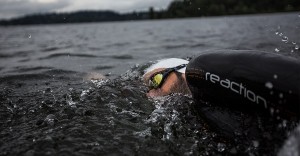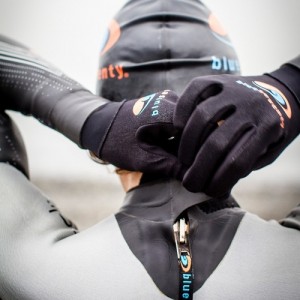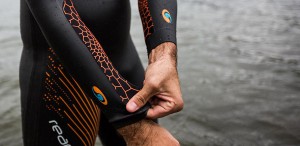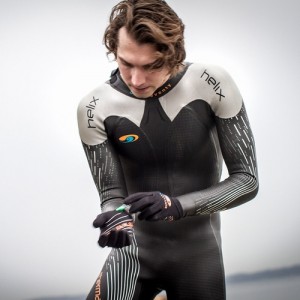Written by Eric Levario, Age-Group Triathlete and Customer Service Specialist
There is a lot of angst and a lot of questions that come up when looking for a wetsuit for triathlons. I emphasize “for triathlon” because these suits fit tight and allow minimal amounts of water in your suit. The term wetsuit implies that water will enter your suit and that is to be expected. Your body will warm this water and it will act as the insulating barrier when swimming in chilly water. If your suit lets in too much water, this will diminish the buoyancy your suit provides and may indicate your suit is too large.
Now how do you pick the right wetsuit for you? It seems easy to look at the sizing charts provided by Blueseventy or HUUB and see where you fit in their sizing charts. I caution you though; one person’s perfect fitting suit may feel too tight to another person. This has to do with general comfort levels and the experience of the triathlete in a triathlon wetsuit. It’s important to remember that these suits are going to feel tight. It may feel a little uncomfortable because it’s squeezing your chest and may give you the feeling of claustrophobia. The best advice I can give you is to do your best to get comfortable with a little discomfort. Walk around your living room with the wetsuit on, take a shower in it, and get it wet. What you’ll find is the suit will loosen a bit. When you feel comfortable, go for a swim. You’ll find that a suit that you thought did not fit you may actually be the perfect one for you. Here are some tips to consider when looking for a wetsuit.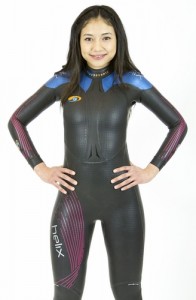
Buoyancy is not everything
Most triathlon wetsuits are made the same way. They have thin neoprene through the shoulders and neck, and thick neoprene on the low torso and legs. While this distribution of thicknesses seems perfect for those of us who drag our feet, it is not ideal for everyone. This distribution is made to correct a less than ideal swimming position by bringing the legs up, like a pool buoy. If you come from a swimming background or lead your masters swim practice, you may find that a traditional wetsuit lifts your hips too high. This gives the feeling that you’re swimming downhill. Contrary to the belief that this should be faster, it is slower and requires adjusting swimming form. If you already have a good hydrodynamic position, you do not need the additional flotation in your legs and hips. What you need is a uniform, buoyancy suit that offers balance. You may have worked hard to perfect your position. A balanced suit will provide the needed improvement in buoyancy in an effort to stay balanced in the water. You should not have to learn to swim in an unbalanced suit if you don’t need the help. You may have come across suits that are built different, like the new 2XU Ghost or the HUUB Archimedes 4:4. These suits have one thing in common; they don’t follow the usual construction of traditional triathlon wetsuits. These suits are designed for already strong swimmers who don’t need that extra lift.
Comfort is king
I can’t stress enough how important it is to find a suit that fits properly. When selecting a suit based off a size chart, keep in mind that there was a model the suit was made after. This means the suit was made to fit a certain body that was likely not yours. When looking at a sizing chart, base your size guess from the weight chart, rather than the height. This will give you a better chance of finding a suit that will likely fit. It’s ok if you wear a size large wetsuit but usually wear a medium trisuit. If you’re comfortable, you’re usually faster. That’s all that matters in triathlon.
Don’t just go for the cheapest wetsuit
Wetsuit fit and comfort is a personal thing. You may look at a high-end wetsuit and think “That’s crazy! No suit is worth that much!” The difference between an entry-level wetsuit and a high-end suit is much more than just price. Entry-level suits are generally made with low-priced neoprene (a.k.a. rubber). This neoprene is very durable, but flexibility is limited. The majority of triathlon wetsuits are constructed with a certain type of neoprene called Yamamoto. They are generally constructed with one of three different grades. The three grades are Yamamoto 38, 39, and 40.
Yamamoto 38 is what the majority of entry-level suits are made with. It is durable, and the least expensive of Yamamoto rubber. This grade also has the least flexibility of the three. This rubber is used in the TYR Category C1 and C3. This will give you a very desirable price for an entry-level wetsuit. When getting into the sport of triathlon, it is a cost-effective way to get a suit without breaking the bank.
Yamamoto 39 is the mid to high level grade of rubber. This is used mostly in middle to high level wetsuits like the TYR Hurricane C5. One of the best “bang for your buck” materials, as it provides greater flexibility and gives up little in durability over Yamamoto 38. The rubber is more supple and will give you improved comfort through your swim.
Yamamoto 40 is a high-level grade of rubber. This rubber is very pricey and usually is only found in high dollar suits. These are the TYR Freak of Nature, Blueseventy Helix, Zone3 Victory D, and other top of the line suits that have a bit of sticker shock with them. This rubber has the most flexibility, is light in weight, and will feel the softest to touch. When a suit is made with this neoprene, the whole point of it is comfort and flexibility. With the flexibility, however, the suit is less durable and is more susceptible to damage from fingernail holes and tearing because of its supple material.
With these grades in mind, you may want to think about what is most important when deciding on a suit. For the majority of people, Yamamoto 38 and 39 are the best value for the money. When in doubt, try them on. You will not know how a suit really fits until you go for a swim with it.
Don’t just go for the most expensive wetsuit either
We know the attitude that the more money you spend the better quality product you’re going to get. In the case of wetsuits, some people feel that the highest dollar option will give them the best time-savings. This is not the case with wetsuits. While marketers can talk all day long about the features that their wetsuit has that will make you faster, more comfortable, and give more flexibility, the fit of your suit is much more important than how much you spend on it. A well-fitting, entry-level suit will ultimately be faster for you than an ill-fitting top of the line suit. This means that if you find comfort in a lower dollar wetsuit, you are not giving up much time to a high-end suit. We’re talking seconds for a full IRONMAN swim.
There are many wetsuits out there which can make these decisions difficult. Now you are better and more informed to make the right decision for you. Knowing how wetsuits are made and with what materials will help you weigh your options on which suit is the best bang for your buck. For some, that will be high-quality neoprene in the shoulders and neck. Others will look at the makeup of the suit to aid their swimming form. Whatever is most important, you will be able to make an educated decision on what these new wetsuits have to offer and what will give you the greatest benefits.

